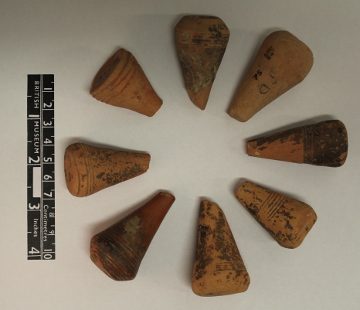Original post on the ERC TwoRains Blog, HERE.
Greetings! – this is Alessandro and I am one of the ceramics specialists for the ERC TwoRains project. For my PhD research, I am pursuing a holistic approach to the study of archaeological ceramic materials from Indus urban and post-urban sites being excavated by the project to trace social continuity and transformations within the production systems of rural communities.
Long story short: I spend a lot of time looking at fragments of pottery, thin-sections and ceramic powder samples. I am combining technological and compositional methods to study ceramic industries, including thin-section petrography, XRD, FTIR, WD-XRF and pXRF. Combining these methods with traditional morpho-stylistic analysis, I am investigating the production (chaîne opératoire) of artefacts to understand synchronic and diachronic cultural behaviour.

In the last 6 months, I have been taking short breaks from microscopes and databases in Cambridge to explore the basements at the British Museum, London. Under the supervision of Dr Daniela De Simone, Tabor Foundation Curatorial and Research Fellow, South Asian Archaeological Collections, I have had the chance to make a small contribution to the new Indus displayed collection. In fact, the well-known Room 33 – China, South Asia and Southeast Asia – is currently closed and Curators at the BM are working hard to present the refurbished gallery by November 2017 (do not worry, no spoilers here for you)!

Daniela has been working on the new display of Indus cases, and I have been helping her reassess some of the artefacts hidden in the basement, which is a cavern of archaeological wonders, ranging in date from Neolithic Balochistan to the Early Historic period; from Indus crafts to Buddhist art; and from ceramic figurines and vessels to metalworks and semiprecious stones.

In addition to digging in boxes and archives in the basement, we have also explored collections from other museums looking for pieces that might contribute to the new display, including the Institute of Archaeology Collections, at UCL. I am sure you will be positively surprised when Room 33 is open again! You can have a flavor of the recently documented artefacts on the online catalogue of the British Museum here: https://www.britishmuseum.org/research/collection_online/search.aspx
Our work concentrated mainly on Urban Indus (c. 2500-1900 BCE) material culture, especially from excavations at Harappa and Mohenjo-Daro; nevertheless, we could not avoid nose into other sections, and document artefacts from earlier or later periods and neighboring areas. Akra, Periano Ghundai, Sohr Damb and Nal serve just as a few examples of sites that contribute to make this archive a precious resource for future research projects. But amongst all, my favourite non-Indus materials come from the monumental ‘Beatrice de Cardi collection’. The works of Miss de Cardi are worldwide known not only for her pioneering explorations in Baluchistan – e.g. Quetta Valley and Kachi plain – but also in the Persian Gulf, Oman and the United Arab Emirates. If you want to know more about her work, have a look at the Council for British Archaeology page, where a summary of the 34th Beatrice de Cardi Annual Lecture is presented: http://new.archaeologyuk.org/beatrice-de-cardi-lecture-2014

Last but not least, Daniela knows about my involvement in Museum education at the Victoria and Albert Museum in London, and National Museum of Oriental Art ‘Giuseppe Tucci’ in Rome. So, she challenged me once: “Can we make a board games for kids and young adults to make them engage the Indus collection even more?” – That is how ‘The Treasure of the Unicorn’ board game was born. It is currently in its ‘beta testing’ phase and we will use photos from objects displayed in the new gallery. Hopefully, we will soon be able to play with it and guide the younger public to approach the fascinating Ancient Indus Civilisation and its technologies and crafts.
Time to go back to my Indus pots and thin-sections from Haryana and Uttar Pradesh. Stay tuned for more news on Ancient Indus crafts and technologies!
Yours faithfully,
Alessandro
